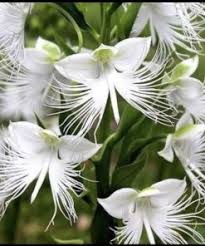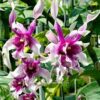# How to Successfully Combine Dendrobium Orchids with Other Plants

Dendrobium orchids are renowned for their stunning beauty and diversity, making them a popular choice among gardeners and plant enthusiasts. Their vibrant colors and unique forms can enhance the aesthetic appeal of any garden or indoor space. However, knowing how to effectively pair Dendrobium orchids with other plants is crucial for creating harmonious and thriving plant arrangements. This guide will explore the principles of plant compatibility, design tips, and specific plant pairings that work well with Dendrobium orchids.
## 1. Understanding Dendrobium Orchids
### 1.1 Overview of Dendrobium Orchids
Dendrobium is one of the largest genera in the orchid family, with over 1,800 species. These orchids are native to tropical and subtropical regions, particularly in Asia. They are characterized by their slender stems, elongated leaves, and vibrant flowers, which can be found in various colors, including white, pink, yellow, and purple. Dendrobiums are epiphytic or lithophytic, meaning they can grow on other plants or rocks, respectively, deriving moisture and nutrients from the air and surrounding environment.
### 1.2 Growing Conditions
Dendrobium orchids thrive in warm, humid environments with good air circulation. They require bright, indirect light, regular watering, and a well-draining potting mix. Understanding their specific needs is essential for selecting compatible plants that can thrive in similar conditions.
## 2. Principles of Plant Compatibility
### 2.1 Light Requirements
When combining Dendrobium orchids with other plants, it’s essential to consider their light requirements. Dendrobiums prefer bright, indirect light, which means that companion plants should also thrive under similar lighting conditions. Plants that require full sun or low light may not be suitable partners.
### 2.2 Humidity and Watering
Dendrobium orchids thrive in high humidity, typically between 40-70%. When selecting companion plants, choose those that also prefer moist environments. Additionally, ensure that the watering needs of both Dendrobiums and companion plants align to prevent over or under-watering.
### 2.3 Growth Habits
The growth habits of the plants involved should complement each other. Dendrobiums can grow upright or cascade, depending on the species. Pairing them with plants that have similar growth habits can create a balanced look. Avoid combining them with overly aggressive plants that may overshadow or outcompete the orchids.
### 2.4 Soil and Potting Needs
Dendrobium orchids typically require a specialized potting mix, such as bark or sphagnum moss, that allows for excellent drainage. When choosing companion plants, consider those that can thrive in similar soil conditions. Avoid plants that require heavy, compacted soil, which can retain too much moisture for Dendrobiums.
## 3. Design Tips for Combining Dendrobium Orchids with Other Plants
### 3.1 Layering Heights
To create a visually appealing arrangement, consider the heights of the plants involved. Use taller plants to provide a backdrop for the Dendrobiums, which can serve as focal points. Grouping plants of varying heights can add depth and interest to your arrangement.
### 3.2 Color Coordination
Dendrobium orchids are available in various colors, so choose companion plants that complement or contrast nicely with their hues. For instance, pairing pink Dendrobiums with white or yellow flowering plants can create a striking visual impact. Experiment with different color combinations to find the most appealing arrangements.
### 3.3 Seasonal Interest
To maintain visual interest throughout the year, consider including companion plants that bloom at different times than your Dendrobiums. This way, even when the orchids are not in bloom, the arrangement remains vibrant and engaging. Incorporating evergreen plants can also provide year-round greenery.
### 3.4 Textural Contrast
Combining plants with different leaf shapes and textures can create a more dynamic arrangement. For example, pairing the delicate leaves of Dendrobium orchids with broader, textured leaves can add visual interest and complexity to your display.
## 4. Recommended Companion Plants for Dendrobium Orchids
### 4.1 Ferns
Ferns are excellent companions for Dendrobium orchids due to their shared preference for high humidity and indirect light. Their delicate fronds create a lush backdrop that enhances the beauty of orchids. Some suitable fern varieties include:
– **Boston Fern (Nephrolepis exaltata)**: Known for its graceful fronds, the Boston fern thrives in humid conditions and can help maintain moisture levels in the surrounding environment.
– **Bird’s Nest Fern (Asplenium nidus)**: This fern has broad, wavy leaves that provide a striking contrast to the slender leaves of Dendrobium orchids.
### 4.2 Bromeliads
Bromeliads are another fantastic choice for pairing with Dendrobium orchids. They prefer similar light and humidity conditions and add a unique aesthetic to arrangements. Some recommended bromeliads include:
– **Guzmania**: Known for its bright, tubular flowers, Guzmania adds a pop of color and can thrive in similar light conditions as Dendrobium orchids.
– **Aechmea**: With its striking inflorescence, Aechmea offers visual interest and thrives in high humidity.
### 4.3 Other Orchids
Combining different orchid varieties can create a stunning display. When pairing Dendrobium orchids with other orchids, consider their light and humidity needs. Suitable companions may include:
– **Phalaenopsis Orchids**: Also known as moth orchids, Phalaenopsis have similar care requirements and bloom at different times, providing continuous color throughout the year.
– **Cattleya Orchids**: These orchids have larger, fragrant flowers and can complement the beauty of Dendrobiums.
### 4.4 African Violets
African violets are popular houseplants that thrive in similar lighting and humidity conditions as Dendrobium orchids. Their soft, velvety leaves and colorful blooms can create a lovely contrast with the sleek appearance of orchids. Additionally, they are relatively low-maintenance, making them an excellent companion plant.
### 4.5 Peace Lilies
Peace lilies are another option that pairs well with Dendrobium orchids. They prefer similar lighting and humidity levels, making them suitable companions. Their dark green leaves and elegant white blooms provide a beautiful contrast to the vibrant colors of Dendrobium orchids.
## 5. Tips for Maintenance
### 5.1 Regular Watering
Ensure that both Dendrobium orchids and their companions receive adequate moisture without over-watering. Monitor the soil moisture levels and water accordingly, allowing the potting mix to dry out slightly between waterings.
### 5.2 Fertilization
Dendrobium orchids benefit from regular fertilization during their growing season. Use a balanced fertilizer that is suitable for orchids and apply it according to the manufacturer’s instructions. Be cautious not to over-fertilize, as this can harm both the orchids and companion plants.
### 5.3 Pruning and Grooming
Regularly prune and groom both Dendrobium orchids and companion plants to maintain their health and appearance. Remove any dead or yellowing leaves and spent blooms to encourage new growth and prevent disease.
### 5.4 Pest Control
Monitor both Dendrobium orchids and companion plants for signs of pests or diseases. If any issues arise, use organic pest control methods to protect your plants without harming the ecosystem.
## 6. Conclusion
Successfully combining Dendrobium orchids with other plants can create a stunning and harmonious display, enhancing the beauty of your garden or indoor space. By considering factors such as light requirements, humidity, growth habits, and overall design, you can create a vibrant arrangement that showcases the elegance of Dendrobium orchids alongside other compatible plants. With careful planning and maintenance, your Dendrobium orchids will thrive in their new environment, providing beauty and enjoyment for years to come.

